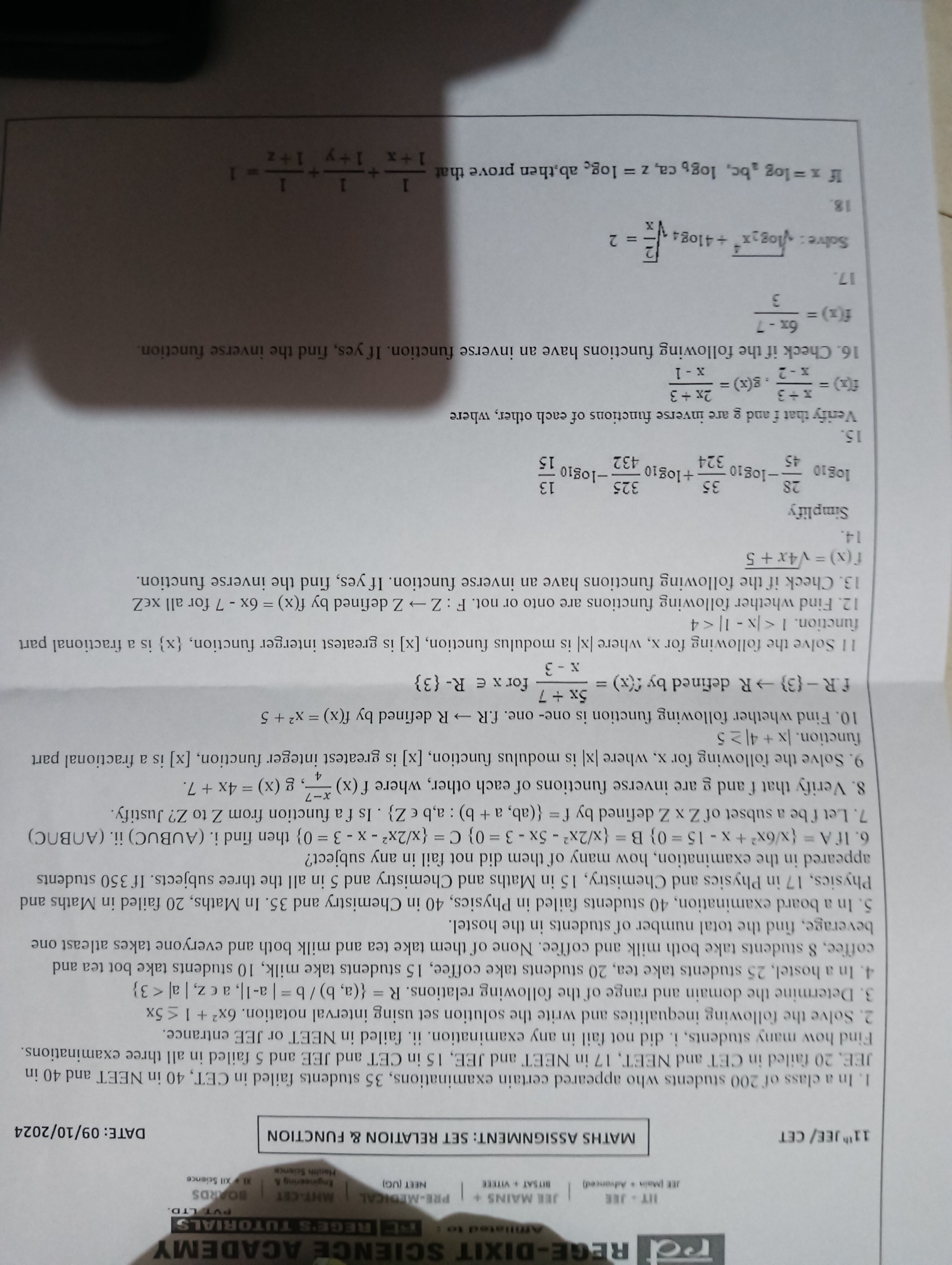1. In a class of 200 students, 35 students failed in CET, 40 in NEET and 40 in JEE, 20 failed in CET and NEET, 17 in NEET and JEE, 15 in CET and JEE and 5 failed in all three exami... 1. In a class of 200 students, 35 students failed in CET, 40 in NEET and 40 in JEE, 20 failed in CET and NEET, 17 in NEET and JEE, 15 in CET and JEE and 5 failed in all three examinations. Find how many students did not fail in any examination. 2. Solve the following inequalities and write the solution set using interval notation. 3. Determine the domain and range of the following relations: 4. Verify that f and g are inverse functions of each other. 5. Solve the following for x. 6. Find whether following function is one-to-one. 7. Find the inverse function if it exists. 8. Simplify the logarithmic expressions. 9. Verify if f and g are inverse functions of each other. 10. Check if the following functions have an inverse function. 11. Solve the equation for the given expression. 12. Prove a logarithmic identity.

Understand the Problem
The question set consists of various mathematical problems related to set relations and functions, including determining domains, solving inequalities, and verifying inverse functions.
Answer
$$ \log_{10} \left( \text{result} \right) $$
Answer for screen readers
The final answer is: $$ \log_{10} \left( \text{simplified value here} \right) $$
Steps to Solve
- Simplifying the logarithmic expression
Start with the expression: $$ \log_{10} \frac{28}{45} - \log_{10} \frac{35}{324} + \log_{10} \frac{325}{432} - \log_{10} \frac{13}{15} $$
Using the properties of logarithms, specifically that $\log_a(b) - \log_a(c) = \log_a\left(\frac{b}{c}\right)$ and $\log_a(b) + \log_a(c) = \log_a(bc)$, combine the logarithms:
$$ = \log_{10} \left(\frac{28 \cdot 325}{45 \cdot 432} \cdot \frac{324}{35} \cdot \frac{15}{13}\right) $$
- Calculating the products and ratios inside the log
Now compute the values step-by-step:
- Start with $28 \cdot 325 = 9100$.
- Calculate $45 \cdot 432 = 19440$.
- Calculate $\frac{9100}{19440}$.
- Now perform $\frac{324}{35}$, and finally multiply by $\frac{15}{13}$.
- Final computation of the log
Insert the computed value into the logarithmic form: $$ \log_{10} \left( \text{result} \right) $$
Once you simplify the ratio, you will provide the final logarithm calculation.
The final answer is: $$ \log_{10} \left( \text{simplified value here} \right) $$
More Information
The above steps require careful handling of logarithmic properties, ensuring each operation is executed correctly. It might also help to check the simplifications at each stage for accuracy.
Tips
- Forgetting properties of logarithms such as $\log_a(b) - \log_a(c)$ leading to incorrect fraction formation.
- Failing to accurately compute products and ratios can lead to incorrect logarithm values.
- Not simplifying ratios before applying logarithms could complicate calculations unnecessarily.
AI-generated content may contain errors. Please verify critical information